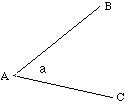 An angle is formed when two lines intersect at a point called the vertex.
An angle is formed when two lines intersect at a point called the vertex.
Angles are usually measured in degrees ( o ) and minutes ( ' ), although there are other systems of measuring angles, such as radians.
Notation
Measurement of Angles
A degree is defined as 1⁄360th of one revolution or turn. i.e. 360° = one revolution
A minute is defined as 1⁄60th of a degree. i.e. 1 degree = 60 minutes (1° = 60')
Types of Angles
- Complementary angles add up to 90°
- Supplementary angles add up to 180°
- Adjacent angles are next to one another and have a common vertex and line.
- Equal angles are called congruent angles.
p and q are adjacent angles.
Angles that lie within a certain range of values are given special names
|
Between 0° and 90° |
||
|
90° |
||
|
180° |
||
|
Between 180° and 360° |
Properties of Angles
|
Adjacent angles on a straight line add up to 180° (Adj. ∠'s on st. line are supp.) |
 a + b = 180° a + b = 180° |
Example |
|
Angles around a point add up to 360° (∠'s at a pt. add to 360°) |
 c + d + e = 360° c + d + e = 360° |
Example |
|
Vertically opposite angles are equal. (Vert. opp. ∠'s equal.) |
 f = g, h = i f = g, h = i
|
Example |
